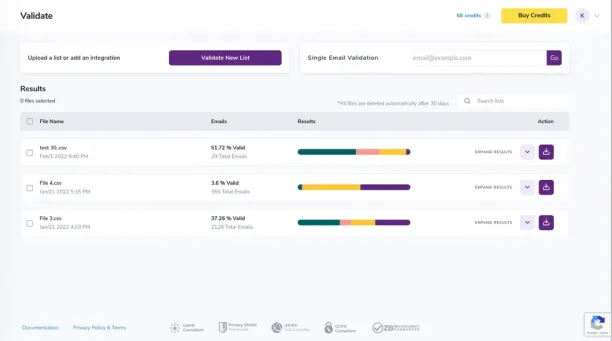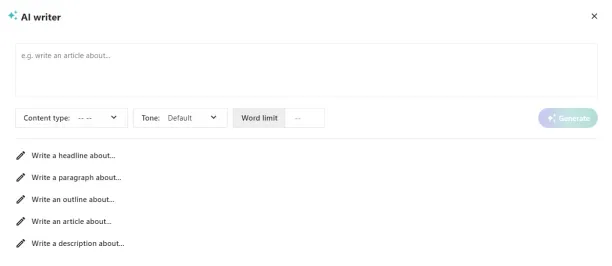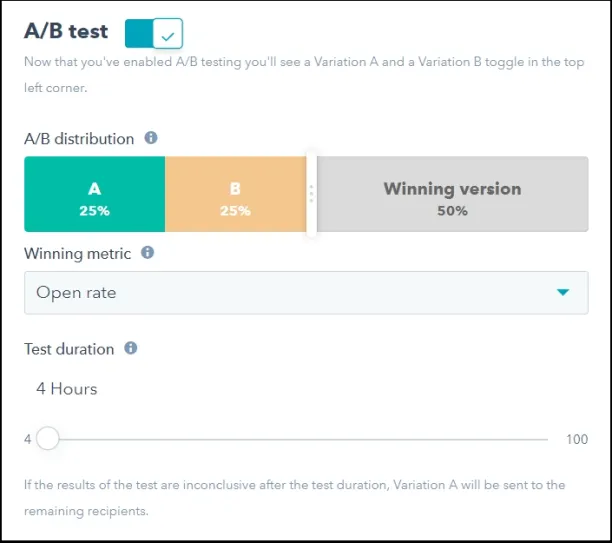Top 10 Applications of AI in Email Marketing in 2024
Integrating AI with email marketing platforms helps managing and automating creative processes, from content creation to sending email marketing campaigns. The aim of AI in email marketing is to increase overall efficiency of email marketing teams, maximizing ROI and customer satisfaction.
By analyzing large volumes of data, AI in email marketing can predict customer behavior, tailor content to individual preferences, optimize send times, and continuously improve campaign strategies based on real-time feedback.
This guide enables a comprehensive look on how to leverage AI in email marketing by explaining top 10 applications and real life examples.
What is AI in email marketing?
AI in email marketing leverages historical data to dynamically insert content relevant to the individual’s recent interactions.
By analyzing user preferences and behavior, AI email marketing tools can adjust content and subject lines to resonate better with potential customers and fine-tuning email marketing efforts based on detailed customer insights.
AI tools also predict the best timing and content strategies for future campaigns to support email marketers to optimize campaigns and improve email performance.
AI technology in email marketing enables A/B testing automation to maximize inbox delivery and click-through rates.
AI platforms also analyze user feedback using sentiment analysis which would provide email marketers with data-driven insights to continuously improve email marketing strategies.
Here are top 10 applications to leverage artificial intelligence for your email marketing efforts:
1. Send time optimization
Send time optimization includes using artificial intelligence to determine the most effective times to send emails to recipients with the aim of maximizing engagement and key metrics, such as opens and clicks. Key components on how send time optimization works are:
Understanding recipient behavior: AI analyzes historical data on recipients’ interactions with emails to identify the most likely times they will engage with content.
Segmentation by time zone: With artificial intelligence, you can segment email lists by time zone which would allow you to adjust send times to match the best local time for each recipient.
Predictive analytics: AI uses machine learning mechanisms to predict future recipient behaviors and adjust send times accordingly while considering variations like weekdays versus weekends and holidays.
Real-time adjustments: AI tools can dynamically alter send times based on immediate campaign feedback to boost engagement if initial results are not satisfactory.
Testing and learning: Through A/B testing, AI continuously refines its understanding of optimal send times while adapting to changes in user behavior and preferences.
Via these steps, send times are individualized. This can reduce email fatigue.
Real life example: Daily deals
A daily deals business, Groupon, relied primarily on notifications for revenue and have sent too many emails resulting in email fatigue and a significant loss of value for their businesses.1
2. Email validation
Businesses can easily adopt email validation services to validate new signups or existing email addresses.2
Most of the technology used by email verification services doesn’t involve AI, it involves attempting to send emails. However, using machine learning technologies, these businesses can reduce the number of emails they send.
AI-powered email validation is an essential aspect of maintaining email marketing effectiveness. It primarily ensures that the email addresses in your marketing lists are accurate and deliverable. Here are some of key components:
Real-time email verification: Artificial intelligence tools check the validity of email addresses as they are entered into systems. This involves verifying the formatting of the email address on the server. These AI tools help to quickly identify and eliminate errors like typos and fake addresses.
Predictive analysis: With AI, you can predict issues that may lead to email bounces and deliverability problems by identifying patterns such as problematic domains or suspicious signup activities.
Automated list cleaning: AI automates email list cleaning processes by periodically removing or flagging addresses that show signs of non-engagement or frequent bounces, which would improve the health and effectiveness of email campaigns.
By improving email validation processes, AI-driven systems help minimize email bounce rates, which are the number of emails sent to non-existent addresses, and maintain the sender’s reputation and deliverability.
Real life example: ZeroBounce email validation services
ZeroBounce analyzes a broad range of data to assess the quality of an email address. This software detects various patterns that can be positive or negative within an email address and provides a dependable score for users to use in their email hygiene practices. Additionally, ZeroBounce’s email validation services are regularly updated to reflect changes in email trends.3

Figure 1: ZeroBounce email validation service.4
3. Customer feedback analysis
By leveraging advanced AI technologies, companies can gain deeper insights from their feedback data to improve customer satisfaction. Key concepts on how AI is utilized for customer feedback analysis in email marketing include:
Automated feedback collection: AI tools can automate the feedback processes by sending personalized emails on post-customer interactions at optimal times. This approach would result in increased response rates and more personalized content based on recent experiences.
Sentiment analysis: Utilizing natural language processing (NLP), AI determines the sentiment expressed in feedback such as positive, negative, or neutral and categorizes it into themes.
Customer journey mapping: AI compiles feedback from various customer journey stages, while offering a comprehensive view of customer experiences to optimize touch points for increased satisfaction.
4. Email inbox management
You can leverage AI technologies to automate many of the routine inbox management tasks such as sorting incoming emails, prioritizing responses, and handling unsubscribes and complaints. Here’s how you can use AI for effective email inbox management in email marketing:
Automated email categorization: AI systems can automatically sort incoming emails into specific categories based on content, sender, and urgency. This organization aids marketers in managing their workload more efficiently and ensures important emails are not overlooked.
Smart response suggestions: AI can analyze the content of emails and suggest appropriate draft responses, which can then be personalized by the user. This speeds up the response process while maintaining consistent communication quality.
Automated responses and chatbots: You can handle standard queries and frequently asked questions with artificial intelligence through automated responses or chatbots by providing instant information to customers.
Email performance tracking: AI tools automatically monitor key performance indicators of email campaigns, such as open rates and click-through rates. This data helps refine future campaigns and prioritize effective email marketing content.
Real life example: Gmail Smart Reply
Gmail’s Smart Reply service employs machine learning methods, such as deep neural networks to select the most suitable responses from a broad range of options. Rather than sending basic replies to an invitation like “Yes,” “No,” or “Maybe,” Smart Reply offers more detailed choices such as “Sounds great, count me in,” or “Sorry, I can’t make it tomorrow”.5

Figure 2: Gmail Smart Reply service.6
5. Churn prediction and prevention
AI’s role in churn prediction for email marketing is critical for identifying potential customer loss before it happens. This approach allows businesses to proactively engage and retain customers. By leveraging various machine learning models and data analytics techniques, AI can predict which customers are likely to churn.
Behavioral patterns recognition: AI tools enable detection of subtle changes in customer behavior that may signal a risk of churn. This includes decreased engagement with emails, fewer website visits, or changes in purchase behavior such as reduced order values or frequency.
Segmentation for at-risk customers: AI not only predicts which customers are likely to churn but also segments these customers into different risk categories. This segmentation enables more targeted and efficient re-engagement strategies.
Personalized retention campaigns: With the identification of at-risk customers, AI facilitates the creation of personalized re-engagement email marketing campaigns.
6. Content and subject line optimization
By utilizing artificial intelligence and machine learning algorithms, you can prioritize content and subject line optimization. These automated email subject lines and email content can resonate better with your target audience.
This AI application allows for the personalization and improvement of every aspect of email marketing content, from the email subject lines that first catch the recipient’s eye to the main content that drives action. Here’s how AI transforms content and subject line optimization in email marketing:
Subject line generation and optimization: AI uses natural language generation and machine learning to craft compelling subject lines that capture attention. It analyzes past campaign data to identify the most effective subject lines for different audience segments, including word choice, length, tone, and emotive triggers.
Tone and style adaptation: You can maintain a consistent voice across emails by adapting the tone and style of communications based on successful past interactions. AI in email marketing adjusts the language’s formality to match the recipient’s demographic profile and interaction history.
Check out generative AI for email marketing to learn about text and image generation for marketing emails.
Real life example: Moosend AI writer
Moosend AI writer enables marketers to generate unique email content or subject line based on the chosen keywords. The AI writer feature also provides options to change or improve the tone of the email message.7

Figure 3: Moosend AI writer feature.8
7. Segmentation and targeting
Segmentation in email marketing is a powerful strategy used to divide a larger audience into smaller groups or segments based on specific criteria, such as demographic details, behavioral patterns, or purchase history.
AI supports the capabilities and effectiveness of segmentation by leveraging customer data analysis and predictive analytics to create targeted and personalized email campaigns. There are three types of segmentation for AI in email marketing:
Behavioral segmentation: AI analyzes behavioral data to segment users based on their actions, such as website interactions (pages visited, time spent), email engagement (opens, clicks, frequency), purchase behavior (history, frequency, spend), and product preferences (items browsed or wish-listed).
Predictive segmentation: Using historical data, AI predicts future behaviors like purchase likelihood, potential lifetime value, or churn risk. This enables marketers to:
- target at-risk customers with retention strategies,
- offer exclusive deals to high-value customers,
- focus on nurturing potential leads likely to convert.
Automated segment adjustment: As AI systems continuously learn and adjust, automatic update processes of segments based on customer behaviors and market conditions change over time. This automatic adjustment ensures that segments stay relevant and that campaigns are always aligned with the latest insights.
8. Automated email campaign management
By utilizing artificial intelligence, you can autonomously plan, execute, and optimize your email marketing campaigns by analyzing customer data, predicting behaviors, personalizing content, and continuously learning from interactions to enhance effectiveness and engagement. Some of the components of automated email campaign management are:
Behavioral email triggers: AI tools utilize user actions as cues for sending automated, relevant emails. Common triggers include:
- Website visits: targeted emails based on visited pages,
- Cart abandonment: reminding customers who leave items in their shopping carts,
- Purchase confirmation: automated thank-you and order confirmation emails,
- Email interaction: Follow-up emails triggered by customer interactions with previous emails,
- Anniversary or milestone: emails celebrating customer milestones like purchase anniversaries.
Automated workflow management: AI helps automation and management of customer journeys, using behavioral data to map out and dynamically adjust email sequences from initial engagement to post-purchase to increase relevance and effectiveness.
9. Product recommendations
AI-driven product recommendations in email marketing utilize machine learning to analyze customer data—such as past purchases and browsing behavior—to personalize email content with relevant product suggestions.
These recommendations are dynamic, adjusting in real-time when the email is opened to ensure relevance.
Feedback loop: The system continuously improves through a feedback loop, where customer interactions with recommendations refine future suggestions.
This personalized approach not only enhances the customer experience by making emails more relevant and timely but also boosts engagement and retention rates by aligning with individual preferences and behaviors across multiple marketing channels.
Real life example: Smart recommender by Insider
Philips implemented Insider’s Smart Recommender, which uses past behavioral data to show relevant product recommendations that lead to an increase in mobile conversion rates and additional revenue.9
10. Automated A/B testing
Automated A/B testing in email marketing uses AI to compare different email versions to determine which one performs better on metrics like open rates and conversions.
Creating the variations: In automated A/B testing, AI algorithms help create variations of email components such as subject lines, email body content, images, call-to-action buttons, and even send times.
Test execution: Once variations are created and the audience is segmented, the AI system automatically sends out different versions of the email to selected segments. This process is handled with minimal human intervention, ensuring that the timing and execution are optimized according to the algorithm’s scheduling.
This process not only streamlines testing by handling large data sets and multiple variations but also continuously refines campaign effectiveness through a learning loop that integrates outcomes from each test to improve future emails.
Real life example: HubSpot A/B testing
HubSpot AI for A/B testing tool enables marketers to experiment with different email elements such as send times, subject lines, and content. Their platform automatically distributes variations and collects performance data, which is then used to determine the most effective email marketing strategy.10

Figure 4: HubSpot A/B testing feature.11
Further reading
- eCommerce Email Marketing in 2024: Guide & Top 5 Providers
- Top 7 Email Marketing CRM Tools in ’24 Based on 30k Reviews
- Top 10 Email Marketing Benefits in 2024
- Top 10 Email Marketing Best Practices in 2024
- Transactional Email vs Marketing Email: Understanding the Differences
External links
- 1. “The secret to Duolingo’s exponential growth“. Lenny’s Newsletter. Retrieved April 16, 2024
- 2. “Email Validation Service“. ZeroBounce. Retrieved April 16, 2024
- 3. “A.I. Email Scoring Documentation“. ZeroBounce. Retrieved April 16, 2024
- 4. “How To Get Started With Email Validation“. ZeroBounce. Retrieved April 16, 2024
- 5. “6 ways Gmail uses AI features to help you save time“. Blog Google. Retrieved April 16, 2024
- 6. “6 ways Gmail uses AI features to help you save time“. Blog Google. Retrieved April 16, 2024
- 7. “Generate text using the AI writer“. Moosend. Retrieved April 16, 2024
- 8. “Generate text using the AI writer“. Moosend. Retrieved April 16, 2024
- 9. “Philips achieved a 40.1% CVR increase with Insider“. Insider. Retrieved April 16, 2024
- 10. “The Ultimate Guide to AI Email Marketing: Tools, Examples, & Actionable Tips“. Penji. Retrieved April 16, 2024
- 11. “A/B test your marketing email“. HubSpot. Retrieved April 16, 2024

Cem is the principal analyst at AIMultiple since 2017. AIMultiple informs hundreds of thousands of businesses (as per Similarweb) including 60% of Fortune 500 every month.
Cem's work has been cited by leading global publications including Business Insider, Forbes, Washington Post, global firms like Deloitte, HPE, NGOs like World Economic Forum and supranational organizations like European Commission. You can see more reputable companies and media that referenced AIMultiple.
Throughout his career, Cem served as a tech consultant, tech buyer and tech entrepreneur. He advised enterprises on their technology decisions at McKinsey & Company and Altman Solon for more than a decade. He also published a McKinsey report on digitalization.
He led technology strategy and procurement of a telco while reporting to the CEO. He has also led commercial growth of deep tech company Hypatos that reached a 7 digit annual recurring revenue and a 9 digit valuation from 0 within 2 years. Cem's work in Hypatos was covered by leading technology publications like TechCrunch and Business Insider.
Cem regularly speaks at international technology conferences. He graduated from Bogazici University as a computer engineer and holds an MBA from Columbia Business School.
Sources:
AIMultiple.com Traffic Analytics, Ranking & Audience, Similarweb.
Why Microsoft, IBM, and Google Are Ramping up Efforts on AI Ethics, Business Insider.
Microsoft invests $1 billion in OpenAI to pursue artificial intelligence that’s smarter than we are, Washington Post.
Data management barriers to AI success, Deloitte.
Empowering AI Leadership: AI C-Suite Toolkit, World Economic Forum.
Science, Research and Innovation Performance of the EU, European Commission.
Public-sector digitization: The trillion-dollar challenge, McKinsey & Company.
Hypatos gets $11.8M for a deep learning approach to document processing, TechCrunch.
We got an exclusive look at the pitch deck AI startup Hypatos used to raise $11 million, Business Insider.
To stay up-to-date on B2B tech & accelerate your enterprise:
Follow on
Comments
Your email address will not be published. All fields are required.